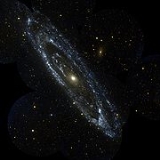
Galaxies in fiction
Overview
Galaxies
other than the Milky Way
are popular settings for creators of science fiction
, particularly those working with broad-scale space opera
settings. Among the most common settings are the Andromeda Galaxy
, the Magellanic Clouds
, and the Triangulum Galaxy
, all part of the Local Group
close to the Milky Way. The difficulties involved in crossing the immense distances between galaxies are often overlooked in this type of science fiction.
The Andromeda Galaxy
has appeared in a number of science fiction
works, as a source of alien
life forms that invade the Milky Way
galaxy, or as a setting for alien worlds
and territories.
Galaxy
A galaxy is a massive, gravitationally bound system that consists of stars and stellar remnants, an interstellar medium of gas and dust, and an important but poorly understood component tentatively dubbed dark matter. The word galaxy is derived from the Greek galaxias , literally "milky", a...
other than the Milky Way
Milky Way
The Milky Way is the galaxy that contains the Solar System. This name derives from its appearance as a dim un-resolved "milky" glowing band arching across the night sky...
are popular settings for creators of science fiction
Science fiction
Science fiction is a genre of fiction dealing with imaginary but more or less plausible content such as future settings, futuristic science and technology, space travel, aliens, and paranormal abilities...
, particularly those working with broad-scale space opera
Space opera
Space opera is a subgenre of science fiction that emphasizes romantic, often melodramatic adventure, set mainly or entirely in outer space, generally involving conflict between opponents possessing advanced technologies and abilities. The term has no relation to music and it is analogous to "soap...
settings. Among the most common settings are the Andromeda Galaxy
Andromeda Galaxy
The Andromeda Galaxy is a spiral galaxy approximately 2.5 million light-years from Earth in the constellation Andromeda. It is also known as Messier 31, M31, or NGC 224, and is often referred to as the Great Andromeda Nebula in older texts. Andromeda is the nearest spiral galaxy to the...
, the Magellanic Clouds
Magellanic Clouds
The two Magellanic Clouds are irregular dwarf galaxies visible in the southern hemisphere, which are members of our Local Group and are orbiting our Milky Way galaxy...
, and the Triangulum Galaxy
Triangulum Galaxy
The Triangulum Galaxy is a spiral galaxy approximately 3 million light years from Earth in the constellation Triangulum. It is catalogued as Messier 33 or NGC 598, and is sometimes informally referred to as the Pinwheel Galaxy, a nickname it shares with Messier 101...
, all part of the Local Group
Local Group
The Local Group is the group of galaxies that includes Earth's galaxy, the Milky Way. The group comprises more than 30 galaxies , with its gravitational center located somewhere between the Milky Way and the Andromeda Galaxy...
close to the Milky Way. The difficulties involved in crossing the immense distances between galaxies are often overlooked in this type of science fiction.
The Andromeda Galaxy
Andromeda Galaxy
The Andromeda Galaxy is a spiral galaxy approximately 2.5 million light-years from Earth in the constellation Andromeda. It is also known as Messier 31, M31, or NGC 224, and is often referred to as the Great Andromeda Nebula in older texts. Andromeda is the nearest spiral galaxy to the...
has appeared in a number of science fiction
Science fiction
Science fiction is a genre of fiction dealing with imaginary but more or less plausible content such as future settings, futuristic science and technology, space travel, aliens, and paranormal abilities...
works, as a source of alien
Extraterrestrial life
Extraterrestrial life is defined as life that does not originate from Earth...
life forms that invade the Milky Way
Milky Way
The Milky Way is the galaxy that contains the Solar System. This name derives from its appearance as a dim un-resolved "milky" glowing band arching across the night sky...
galaxy, or as a setting for alien worlds
Planets in science fiction
Planets in science fiction are fictional planets that appear in various media, especially those of the science fiction genre, as story-settings or depicted locations.-History:...
and territories.
Discussions

